In recent years, hydrangeas in the landscape design of a summer cottage at the peak of their popularity. Gardeners create picturesque plantings of hydrangeas at the dacha, combining varieties of different maturity, flowering period, shades. Although the genus unites about 80 varieties, not all types of hydrangeas are planted in the garden; popular varieties are presented in the photo of the site decorations. Deciduous species grow well in middle latitudes. In warm regions, evergreen varieties of hydrangea are cultivated.

Garden hydrangea - the favorite of many owners of suburban areas
Hydrangea: description and features of the plant
Content
- Hydrangea: description and features of the plant
- Hydrangea in landscape design
- Examples of the design of narrow areas
- Combination with other colors - the best combinations in the photo
- Video: Secrets of growing gorgeous hydrangeas in your garden
- Photo of hydrangea in the garden
The hit of the modern garden design is the hydrangea. The botanical description indicates the corymbose, paniculate and spherical shape of the inflorescences. The flower "garden hydrangea" or "Hydrangea" has dense petals, do not get wet from dew, precipitation. The buds appear on the shoots in spring, bloom until early autumn. Buds droop only after stable frosts. Even the first snow is not terrible for flowers.
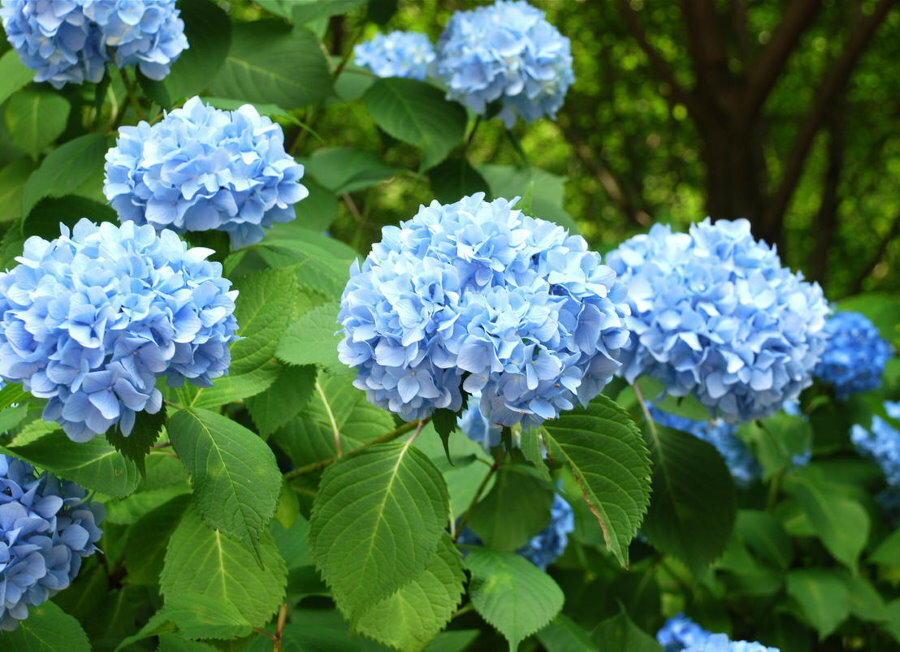
At the sight of these lush buds, there is a feeling of lightness and airiness. I would like to plant whole rows of hydrangeas so that their hats attract attention and decorate the garden plot
Most varieties have a base color of white, less often cream or pale pink. But on the flower beds, colorful hats surprise with a variety. The color of the inflorescences depends not only on the varietal affiliation of the hydrangeas. The acidity index affects pigmentation. The shrub prefers slightly acidic soil. The more acidic the earth, the more shades of blue in the palette. This is due to an increase in the concentration of aluminum. The oxide solution is quickly absorbed by the flower roots.
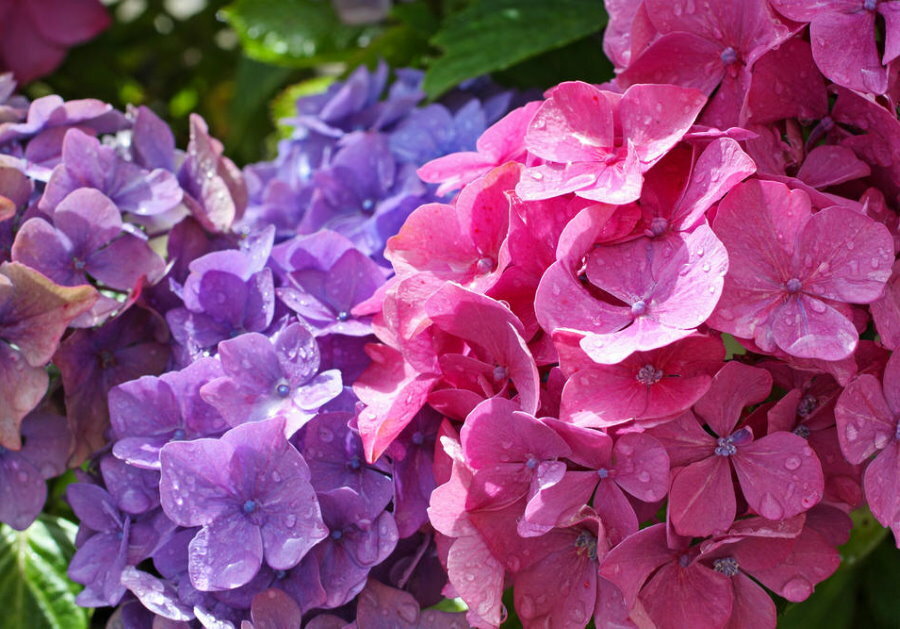
The color of garden hydrangea flowers is highly dependent on the acidity of the soil.
Gardeners determine the pH level by the color of hydrangeas:
- with an increase in alkaline ions, a lilac shade appears or the bushes turn noticeably pink;
- in a neutral environment, the color of the petals is beige, cream, milky or snow-white;
- with an increase in acidity, the flowers turn blue or blue.
The plant is hygrophilous, regular watering is required. In areas with stagnant water, the root system is inhibited, drainage is necessary. Hydrangea is sun-loving, but a little shading is desirable at noon, otherwise the color of the flowers will suffer. The quality of flowering is reflected by an excess of fertilizers; minerals must be applied according to the instructions. With intensive nitrogen feeding, the number of inflorescences is sharply reduced.
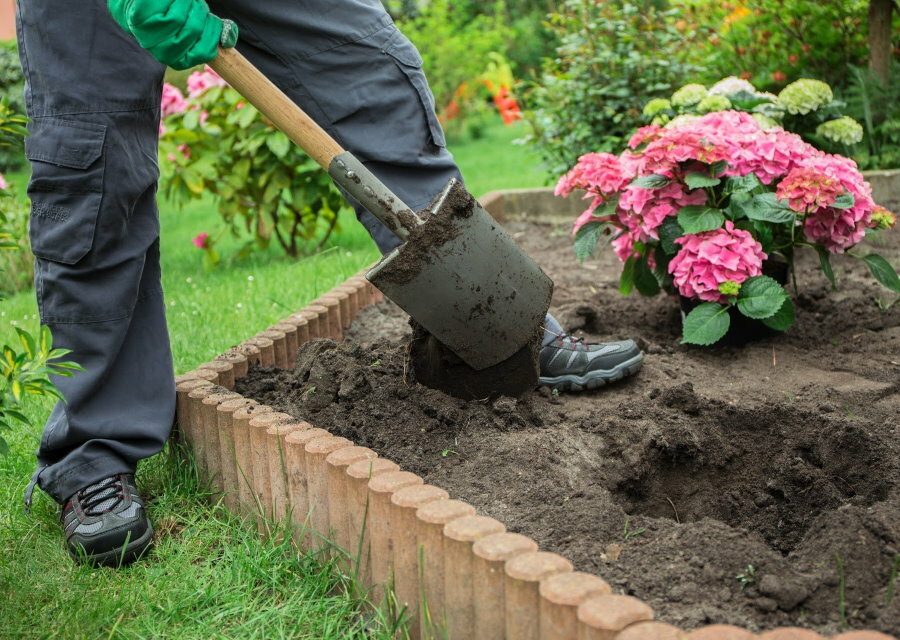
A place for hydrangeas must be chosen in advance, prepare the soil in advance
Winter shelters are recommended in the rules of care. Young bushes are especially carefully covered until the shoots are lignified. Plants reproduce vegetatively and by dividing the bush during transplantation.
Hydrangea in landscape design
Designers decorating gardens and parks distinguish hydrangea bushes as one of the versatile, unpretentious materials.
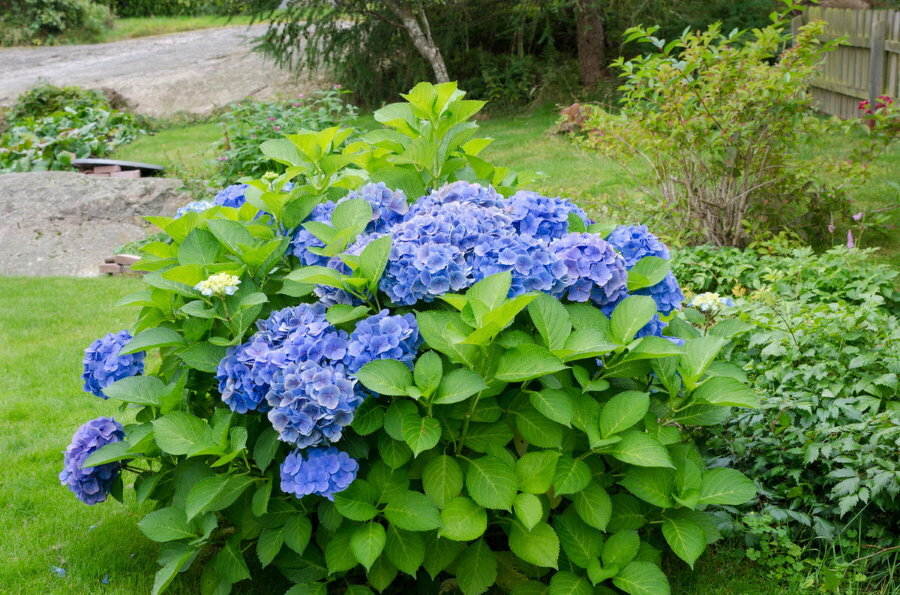
In the garden, hydrangeas are planted singly, in groups or in combination with other plants.
The main advantages of valuable crops:
- compact arrangement of branches, neat crowns are formed;
- flowering duration: the buds open from June to the end of September, the inflorescences remain on the bush until frost;
- decorativeness is created by large, brightly colored sepals;
- a variety of colors: white caps eventually transform into pink, blue, light purple, pale lilac, depending on the variety and pH of the soil;
- resistance to diseases, pests;
- good annual growth.
Flowering shrubs adorn the garden in that part of the summer when the primroses have already faded, and the autumn ones are only forming inflorescences. Hydrangea flowers are often called chameleons, and they change color throughout the season. Hats do not get wet under showers, they please in bad weather.

Shady flower bed with hydrangeas and hosts
Snow-white hydrangea flower photo garden or large-leaved - the most popular variety with semicircular or umbrella inflorescences. In addition, other varieties of hydrangea shrubs are used in landscape design:
- Hydrangea paniculate garden photo is easy to recognize by pyramidal or conical inflorescences. The height of the varieties is from 2 to 5 meters. Bushes can not be replanted until 40 years old. At the end of summer, the brushes first turn light pink, then darken to a terracotta shade. In autumn, they acquire their original light green color.
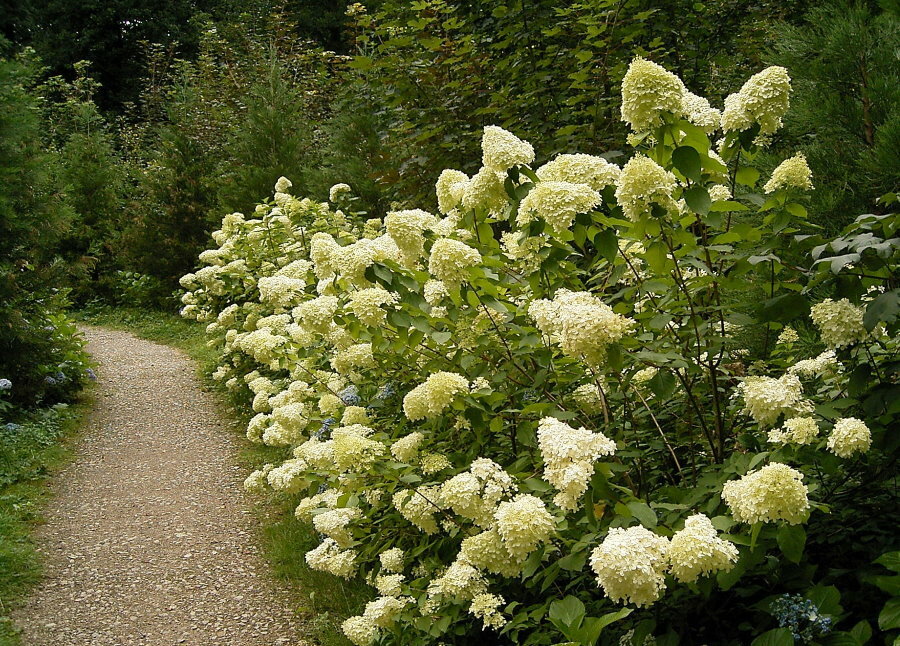
Panicle hydrangea is distinguished by its unpretentiousness, the ability to grow in swampy and gassed places
- Treelike varieties grow up to 3 meters, are frost-resistant. At the end of the season, the flower petals turn cream or remain white.
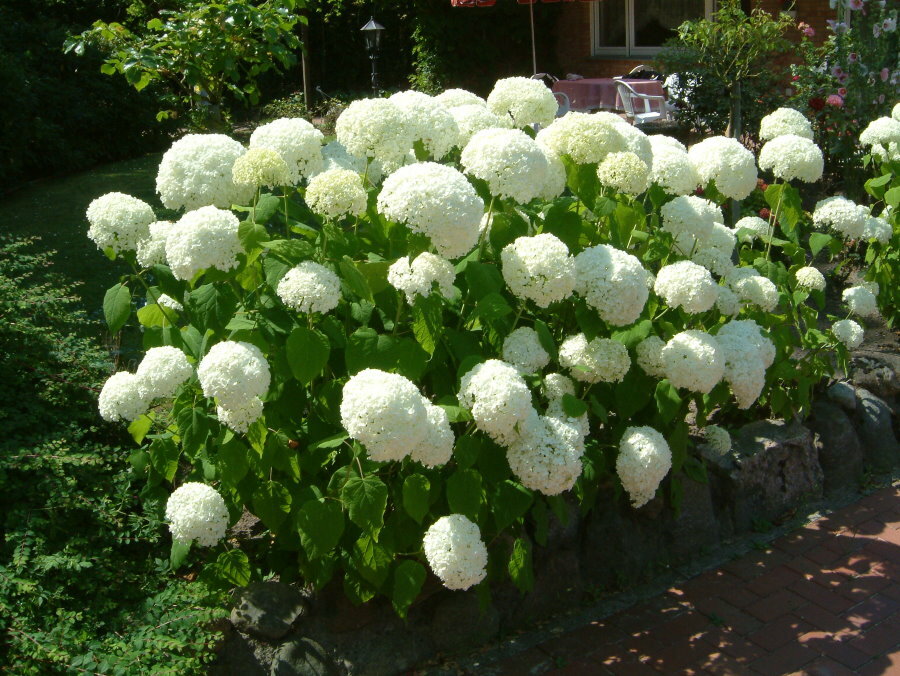
In the photo there is a tree hydrangea - variety "Annabelle"
Treelike varieties are used to create wildly flowering landscapes in a natural style.
- Oak-leaved hydrangea with unusual oak-like leaves must be insulated for the winter. By the appearance of the buds, it resembles a paniculate variety. Flowers turn purple by autumn. The height of the bushes is within 2 meters.
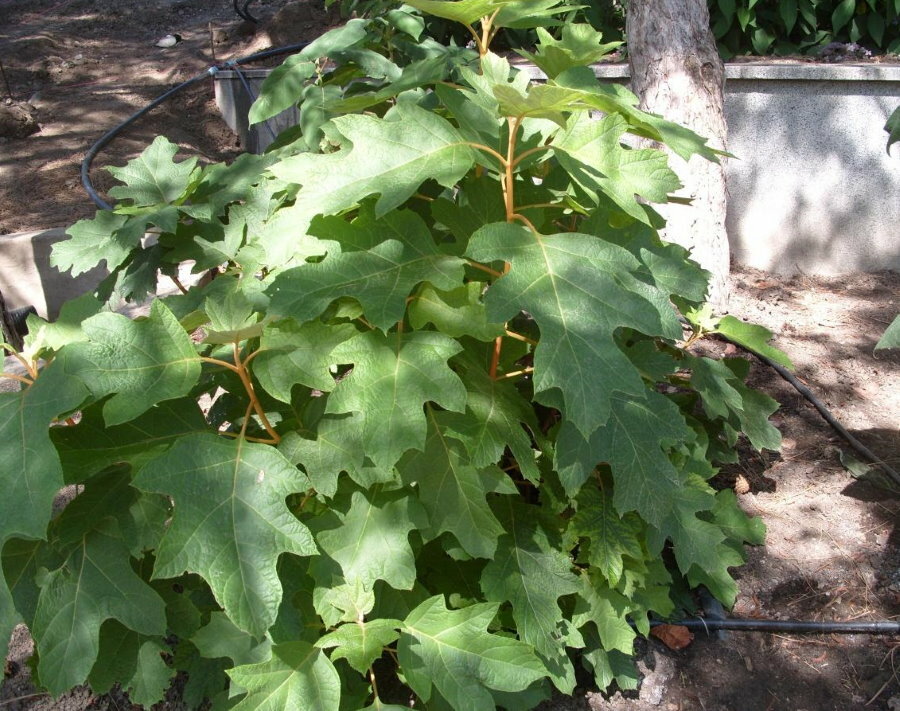
Oak-leaved hydrangea is a heat-loving shrub with interesting leaves
- Winter-hardy ground cover is used for standard forms. Inflorescences are loose, hemispherical or paniculate at the end of flowering turn pink. The leaves are easy to distinguish by the pubescence on the underside.
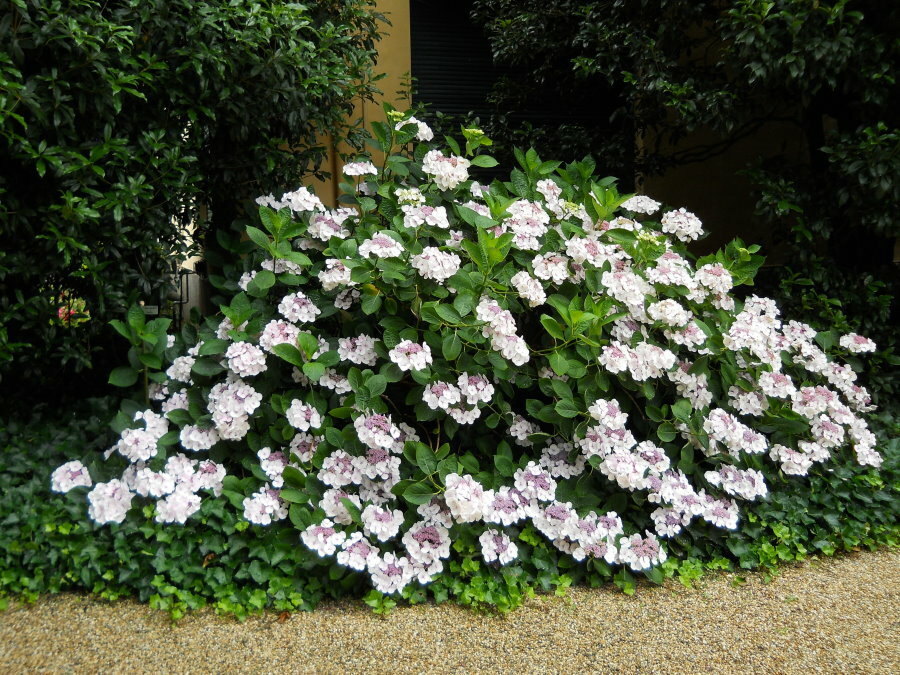
Groundcover hydrangea withstands frosts well up to 30 degrees
- The petiole belongs to the climbing species, the liana rises along the support up to 10 meters, without support it spreads along the ground. The shrub grows slowly for the first 4 years, then gives an intensive growth.

The petiolate hydrangea is great for decorating arches, arbors. pergolas or fences
For decoration, an ash, serrated, radiant, rough hydrangea is grown. When planting curbs, it is advisable to change the acidity of the soil individually for each bush in order to obtain shades of varying intensity. The result is a motley mosaic.
You can acidify the soil to change color with a solution of colloidal sulfur, ferrous sulfate. Some people prefer to mulch the bushes with peat, coniferous litter or leaf humus.
Examples of the design of narrow areas
In landscape compositions in open spaces, hydrangea is used for zonal division. Shrubs that are prone to pruning acquire different shapes and sizes under the garden shears. The perimeter of the site will be decorated with a hedge of hydrangea, hide an unsightly fence.
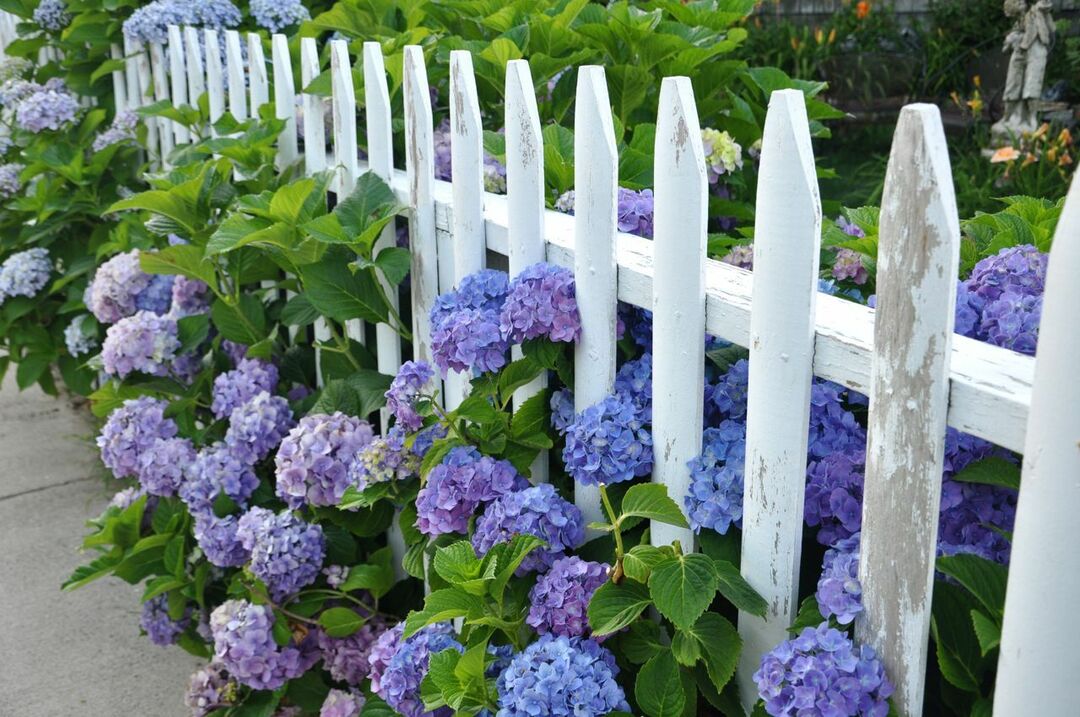
To create hedges or decorate a fence, tree-like varieties of hydrangeas are most often used.
When planting in groups, it is advisable to replant the bushes every 5 years so that the caps of the buds do not become smaller.
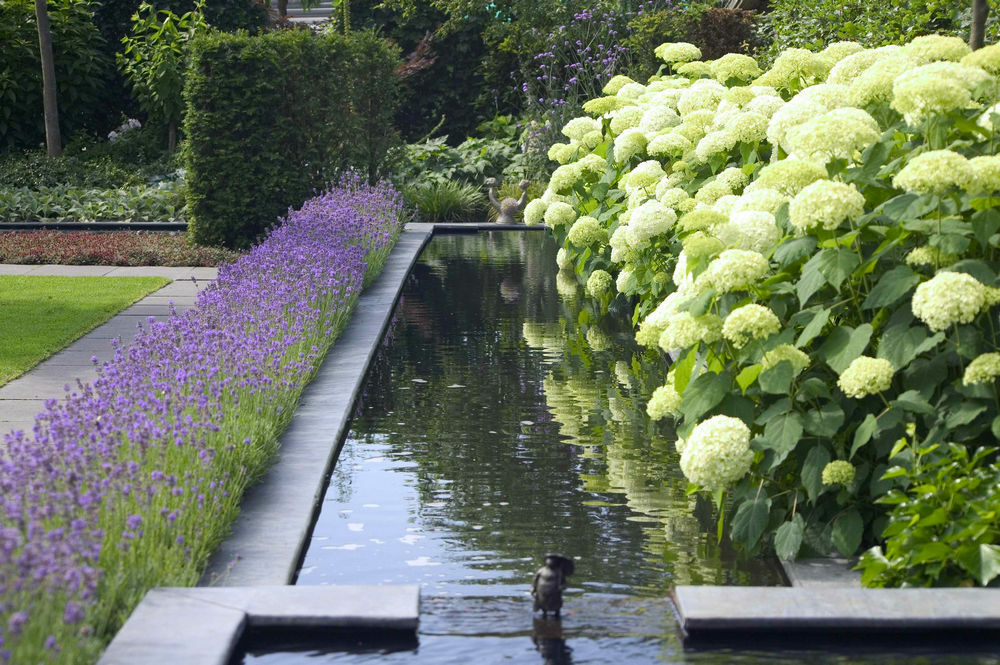
Hydrangea bushes look beautiful on the shore of an artificial reservoir
Examples of how to decorate narrow areas with hydrangea photos will suggest fresh ideas. You can create original compositions by changing the acidity of the soil under the plantings. Large-leaved varieties are combined with ground cover. Treelines are appropriate in the background. Petiolate look unusual, plants use:
- to create vertical flower beds;
- planting in flowerpots on terraces, verandas.
On an elongated landscape, an English garden looks great. A strict distance is observed between plantings, monochrome compositions are diluted with decorative herbaceous crops.
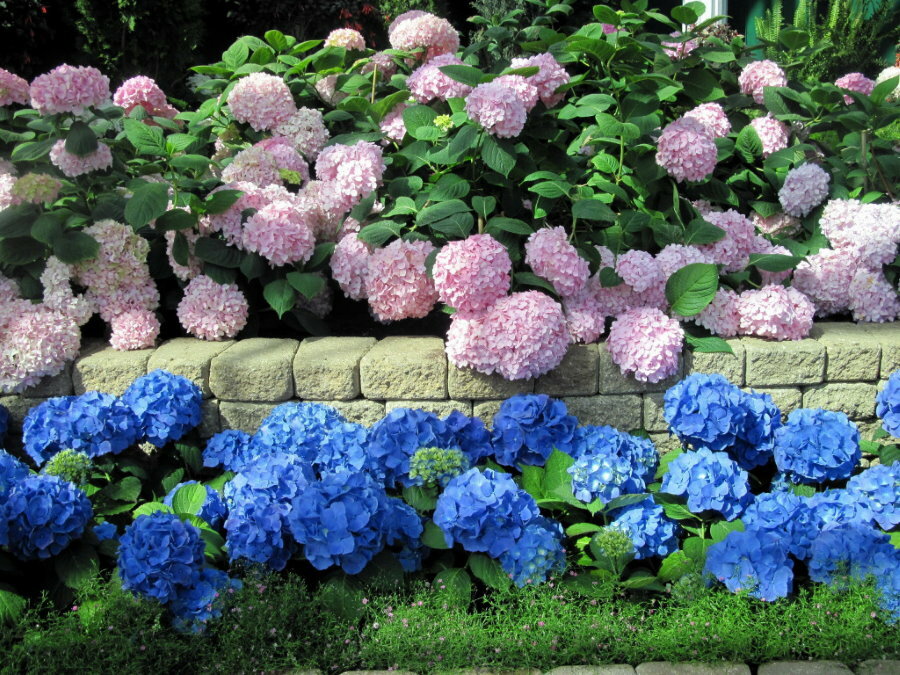
Low-growing varieties are good for decorating the curbs of paths, high flower beds or retaining walls
Shrubs are suitable for decorating a garden in the Russian style: blooming hydrangeas are planted near fruit trees, berry bushes. A single landing at the entrance to the house diversifies the typical façade.
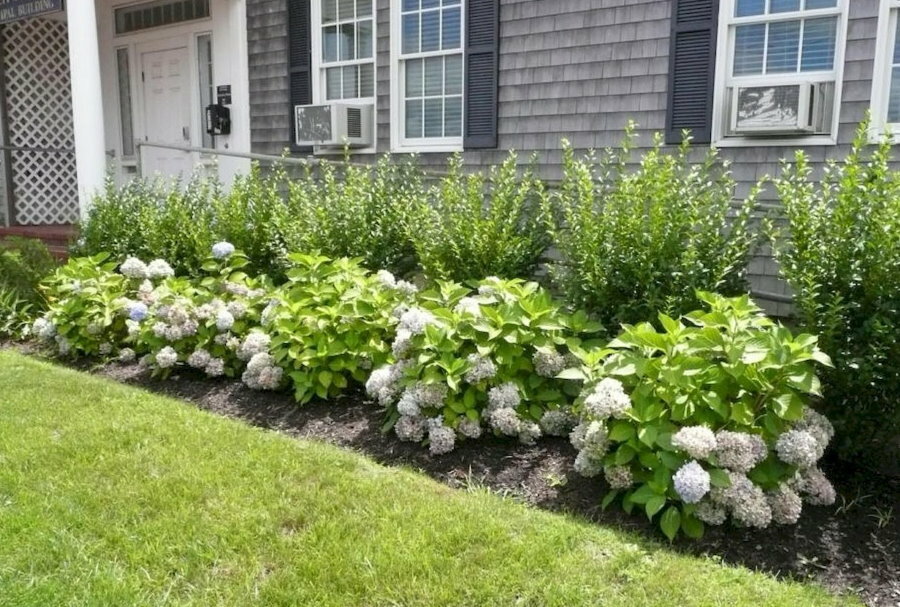
Hydrangeas planted along the wall of the house will decorate the facade of a building from any material
Hydrangea in narrow areas is placed:
- along the tracks;
- on flower beds;
- in remote corners of the garden;
- near reservoirs.
Flower hats will decorate garden furniture, the recreation area will be turned into a cozy place for privacy, and the grace of the gazebo will be emphasized.
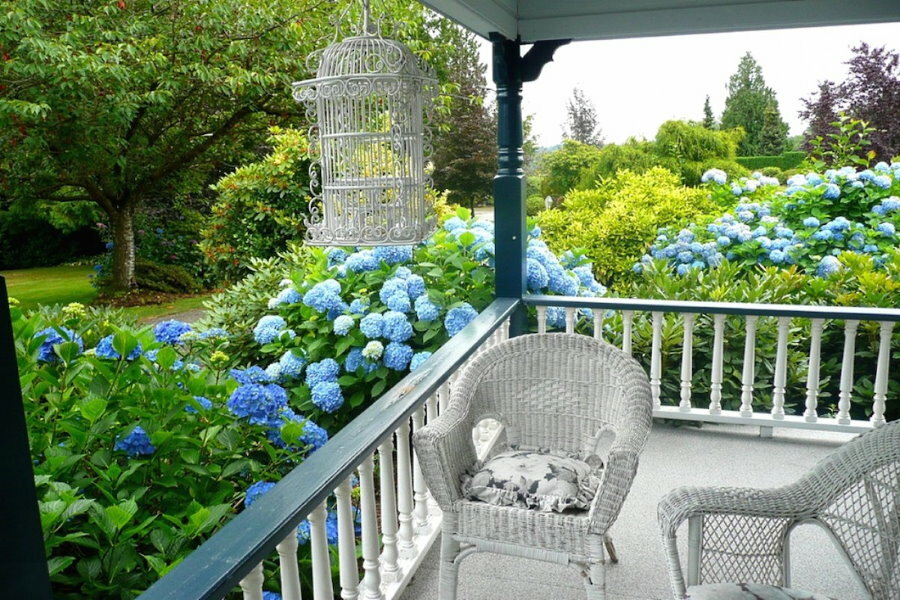
Having planted hydrangeas right behind the terrace railing, you can admire their abundant flowering most of the warm season.
Bushes of large-leaved varieties are best placed inside a flower garden or wet sorber.
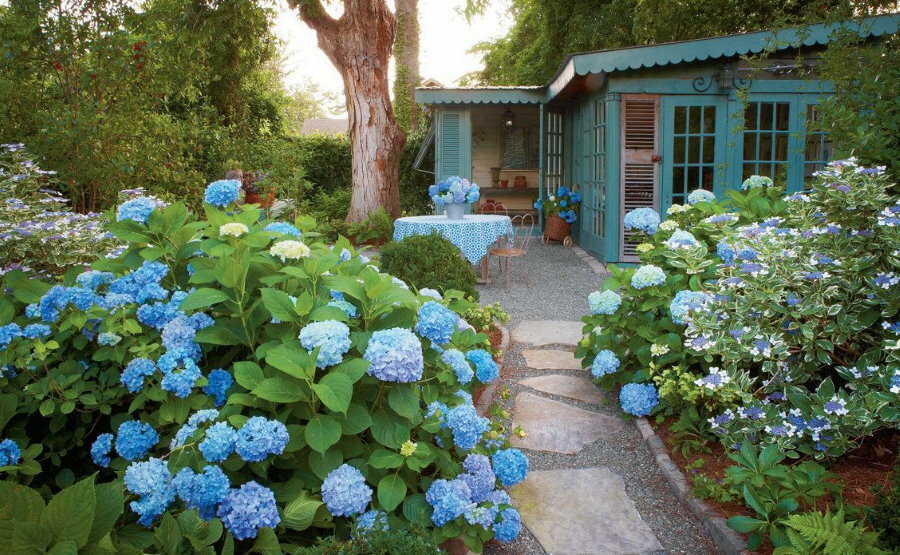
Hydrangeas can be planted both in the shade and in sunny areas.
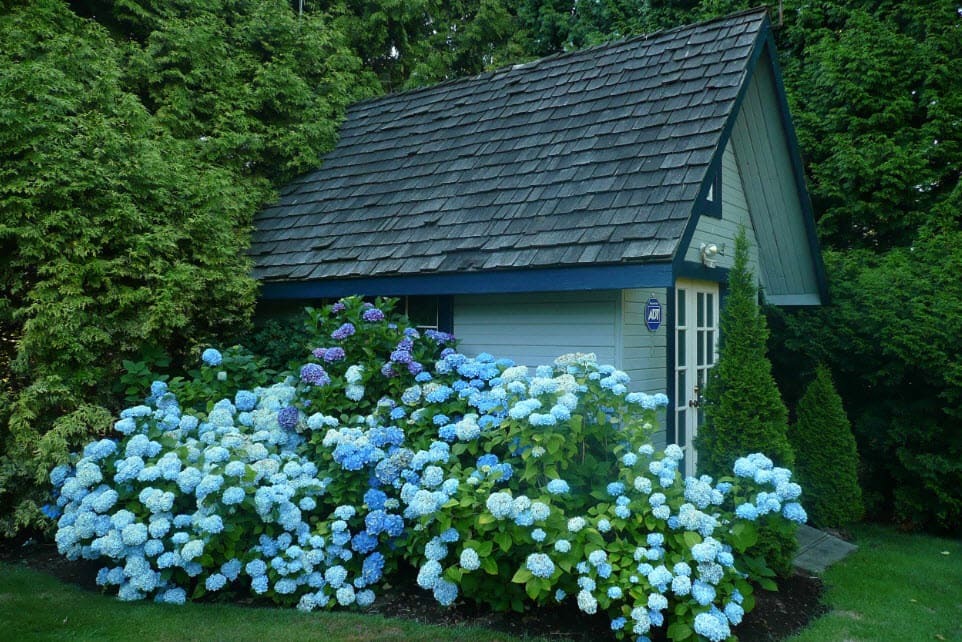
Treelike hydrangea as a decoration for a small shed
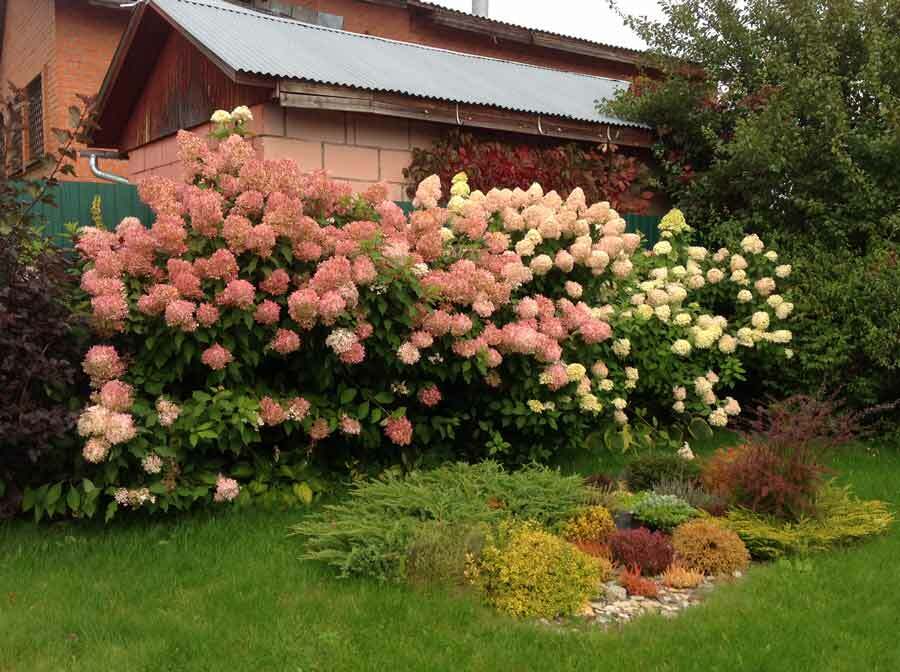
A hedge of hydrangeas with flowers of various colors
Combination with other colors - the best combinations in the photo
The selection contains compositions where hydrangeas play a key role in the garden, the design of the photo will suggest ideas for decorating plots. The flower bushes will be accompanied by perennials and conifers that prefer acidic soil.
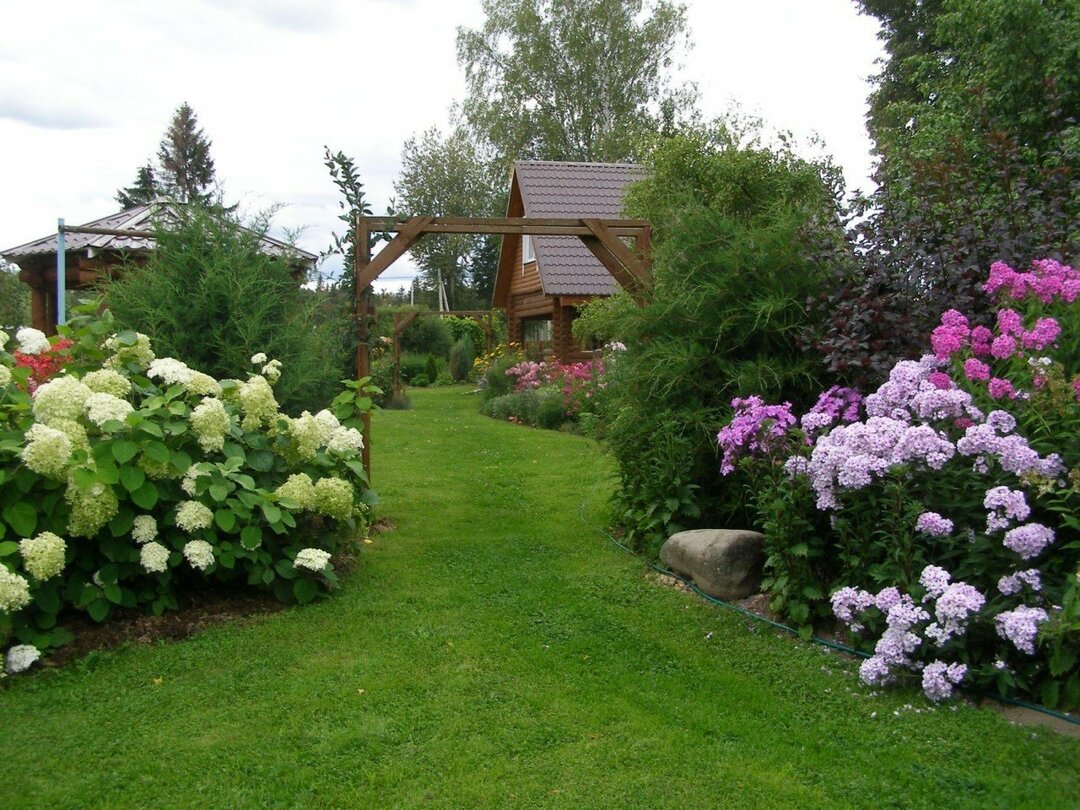
Garden arrangement of hydrangeas and phlox
The decorative properties of the universal hydrangea are visible in the design of the garden, with which flowers the photo is combined:
- white-flowered combinations with shade-tolerant astilbe, physostegia, fluffy phlox, delicate anemones are not uncommon;
- when contrasting compositions are needed, blue aconite can be planted nearby;
- the variety is introduced by the growing nearby irises, daylilies, daffodils, primroses;
- an ideal neighborhood will be lovers of acidic soils, rhododendrons, azaleas, Asian yellow lilies with leaves resembling sedge.
Lush hydrangea bushes harmonize with conifers. The needles create the necessary acidity, oxidize the soil, the neighborhood gives the partial shade that shrubs need. Any kind of conifers are suitable for compositions, the most popular option is a combination with junipers. Tall pyramidal conifers accentuate the beauty of hydrangeas. Topiary boxwood looks exquisite.

Hydrangea gets along well with thuja, as both plants love acidified soil.
Designers like to combine hydrangea with bergenia in mixborders, blooming in early spring, when shoots are just forming on the bushes. In summer, the round large leaves of the badan turn red, contrasting with the jagged green of the bushes.
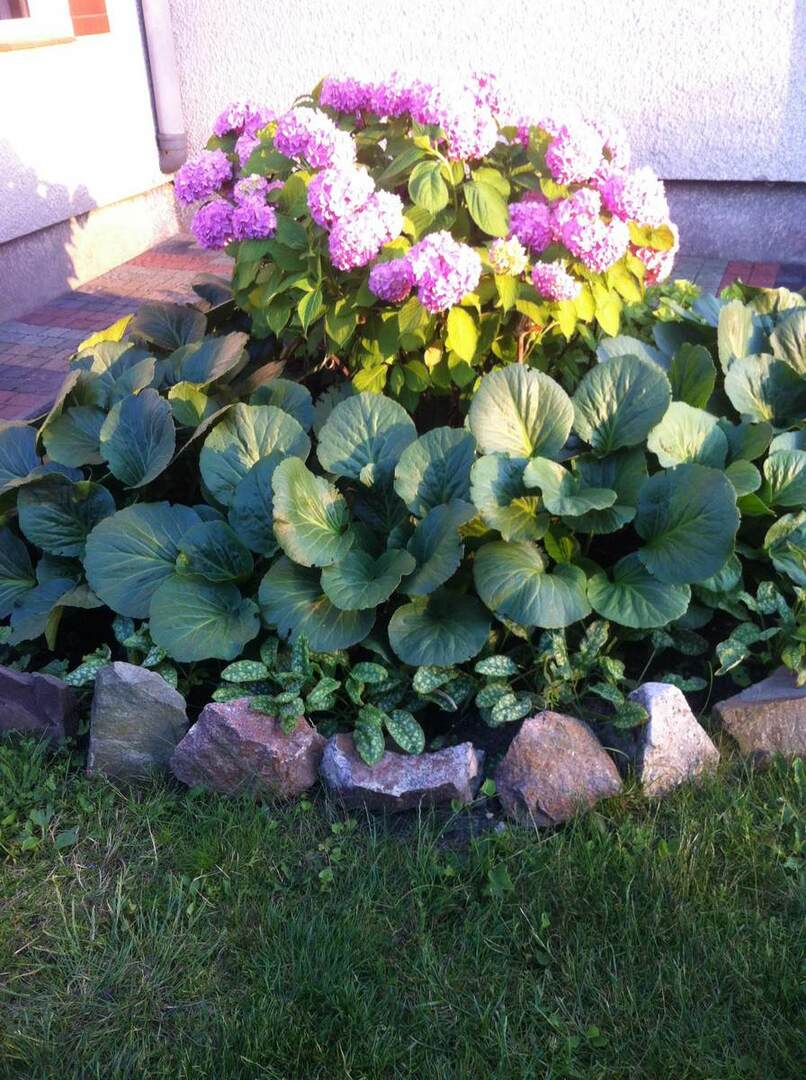
Shrub hydrangea surrounded by thick-leaved badans
Red barberry is another ideal partner. In design, a combination with heather is often used.

Mixed bed with barberry, hydrangea and juniper
Lilacs, spireas create picturesque ensembles with hydrangeas. A successful combination of textures, shapes with hosts that have an original color. The play of shades accentuates the beauty of lush inflorescences. It is advisable to plant a paniculate variety against the background of ground cover crops. Suitable for the neighborhood:
- ivy;
- pachisandra;
- colored periwinkles;
- dark tenacious;
- cuff with light soft leaves.
Hydrangea thrives on lawns planted with grasses that resemble fur from a distance. The green carpet accentuates the elegant appearance of the flowering shrubs when planting solitary.
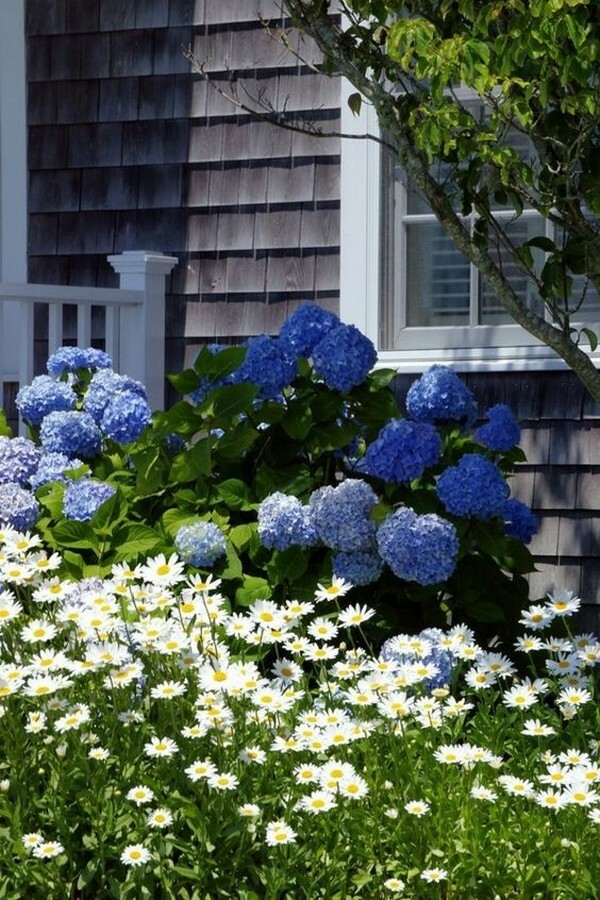
Contrasting combination of dark hydrangea flowers with white and yellow daisies
The buds of colored representatives of hydrangea quickly fade and fade in the sun, the most dangerous is the direct midday sun.
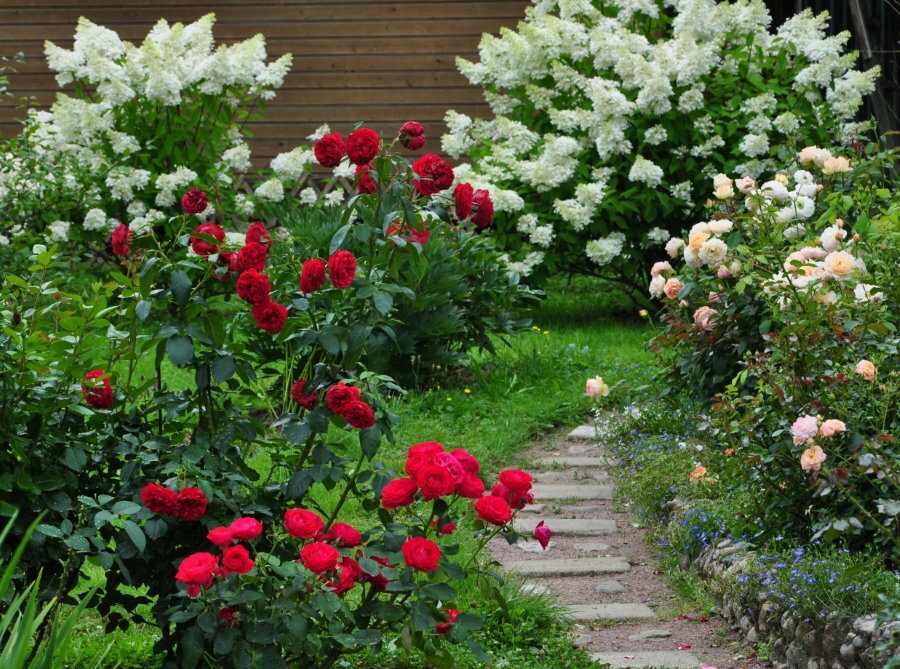
You can plant a hydrangea along with flowers of "royal blood" - roses or lilies
Shrubs clearly declare themselves, fitting into the overall style of the garden, combined with other cultures. Unpretentious varieties of hydrangeas are appreciated in landscape design by decorating art professionals and amateur gardeners. It is appropriate to combine several varieties of hydrangeas, use pruning to create different shapes. Single bushes with lush caps of inflorescences look luxuriously, spectacularly on lawns.
Video: Secrets of growing gorgeous hydrangeas in your garden
Photo of hydrangea in the garden

